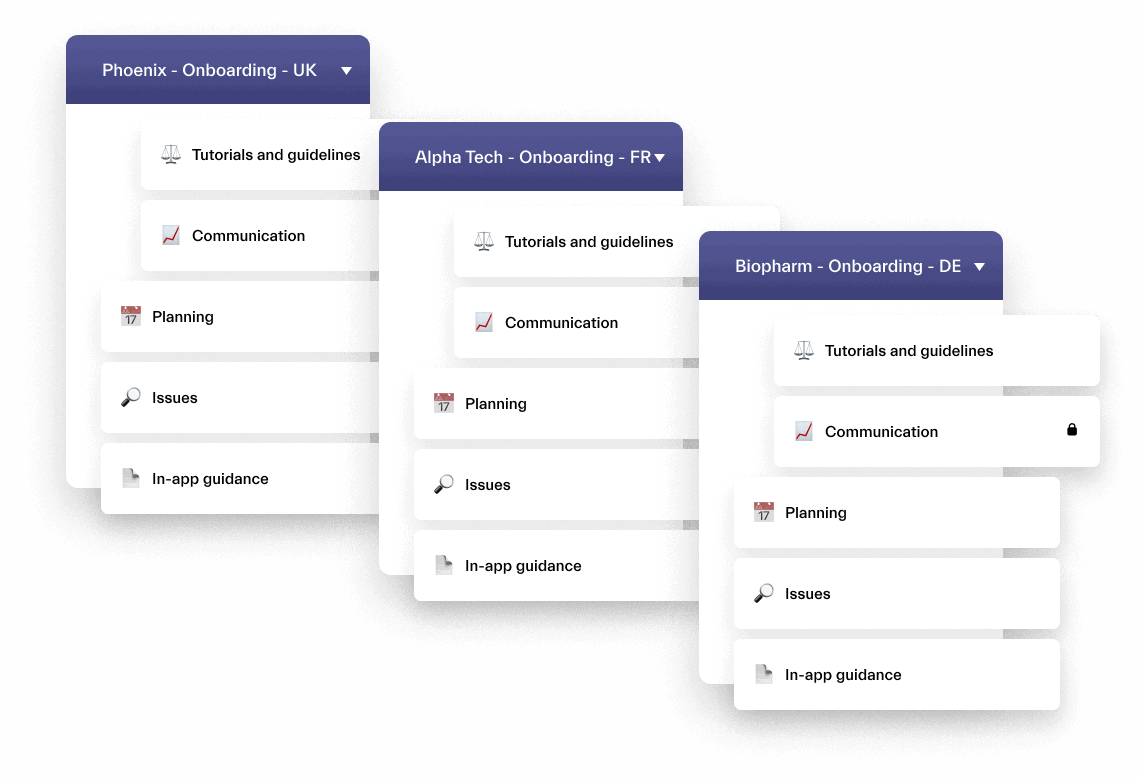Organizations all over the world keep switching to Microsoft Teams as a go-to collaboration platform. Its flexibility and ease of use have made it an indispensable tool for remote work, project management, and more. However, as teams grow and use Teams for an increasing number of purposes, it can become difficult to manage and organize all the different channels, files, and apps that are created. That goes especially for large organizations with multiple branches and departments. This is where Standardizing Microsoft Teams creation comes in. It becomes essential to ensure consistency, and structure in their digital workspaces. In this article, we will discuss why you may want to standardize Microsoft Teams creation, challenges to standardization, how to overcome them and how to implement standardization.
What does standardizing Microsoft Teams creation mean?
Standardizing Microsoft Teams creation is the process of establishing a set of guidelines, templates, and best practices for creating and managing Teams in a consistent and structured way. By standardizing Teams creation, organizations can ensure that each team has a similar structure, contains relevant apps and channels, and is easy to navigate and manage. This can lead to more efficient communication, streamlined workflows, and better overall team performance.
Standardizing Microsoft Teams creation can mean different things for different organizations, depending on their specific needs and goals. For example, some organizations may want to create a standard set of channels and apps that are included in every team, while others may want to create different templates for different types of teams (e.g., project teams, departmental teams, etc.). Standardization can also involve creating guidelines for naming conventions, channel organization, and permissions management.
Overall, the goal of standardizing Microsoft Teams creation is to make it easier for teams to collaborate, communicate, and work together effectively, while also providing a consistent and manageable structure for IT administrators to oversee.
Benefits of standardizing Microsoft Teams creation
Consistency in team naming
Standardization of team naming makes it easy for IT teams to identify and manage Teams. When it comes to users, they can easily navigate among all their teams and collaborate in a more focused way. This consistency can help avoid confusion, duplication of effort, and errors in managing and using Teams.
It also makes it easy for users to find and join Teams relevant to their work. This results in improved collaboration, increased productivity, better communication across the organization, better decision-making and improved results.
Uniformity in team settings
By standardizing Teams settings, IT teams can ensure that all Teams have the same features, capabilities, and governance. This reduces the risk of security breaches, improves productivity, and makes it easier to manage Teams. Standardization also allows IT teams to enforce governance policies and reduce the risk of data loss.
Improved collaboration and communication
By creating Teams with predefined channels and settings, the IT can ensure that users have the necessary tools and resources to collaborate effectively. This can help reduce silos and improve cross-functional collaboration.
Efficient resource allocation
By standardizing Teams creation, IT teams can streamline the process of creating and managing Teams. This will reduce the workload of IT staff and ensures that resources are allocated effectively. Standardization also reduces the risk of errors in the creation of Microsoft Teams. This allows IT teams to focus on other critical tasks.
Improved security and compliance
Standardizing Microsoft Teams creation can also ensure that all Teams are created in a secure and compliant manner. By implementing standard security and compliance policies, IT teams can reduce the risk of data breaches, ensure data privacy, and comply with regulations such as GDPR.
Enhanced user experience
By creating consistent Teams with predefined channels, apps, and tabs, IT teams can help users navigate Teams more easily and find the information they need quickly. This can help increase user adoption and satisfaction.
Challenges to standardizing Microsoft Teams creation
While standardizing team creation can bring many benefits, there are also some challenges that organizations need to overcome to successfully implement it. Here are some common ones.
Complexity of the organization
Large organizations with complex structures can find it difficult to standardize team creation. For example, a global organization with multiple departments and subsidiaries may require different team structures and configurations depending on the location, department, and function.
Lack of centralization
In organizations where teams are created by different departments or teams, it can be tricky to implement a centralized approach to team creation. Each department or team may have its own way of creating teams, leading to inconsistency and confusion.
User resistance to change
Users may be resistant to change and prefer to create their own teams without following a standardized process. This can lead to a lack of consistency and compliance with company policies. Providing training and support can help employees understand the benefits of standardization and reduce resistance.
Security and compliance
Standardizing team creation requires careful consideration of security and compliance requirements. For example, teams may need to be created with specific security settings, or certain types of data may need to be stored in specific locations.
Lack of governance
Organizations without a clear governance model for Teams creation and management may struggle to implement standardization effectively due to inability to enforce policies and ensure compliance. A clear governance model, including roles and responsibilities for Teams creation and management, can help standardize the process and ensure consistency.
To overcome these challenges, organizations can use tools and processes that simplify team creation and ensure consistency. Let’s see what measures organizations can take to address these issues.
How to overcome challenges to standardizing Microsoft Teams creation
Develop a clear governance model
A clear governance model, including roles and responsibilities for Teams creation and management, can help standardize the process and ensure consistency. It is important to include key stakeholders in the process of developing the governance to ensure it aligns with the organization’s overall goals and objectives.
You can learn more about how to defined Microsoft Teams governance in this blog post.
Start small and iterate
You may want to start with a small pilot project to standardize Teams creation, gather feedback, and iterate. This can help refine the standardization process before scaling it up to the entire organization. By starting small, the IT team can test the standardization process, identify any issues, and adjust accordingly before scaling up to the entire organization.
Address concerns and provide training
It is essential to address concerns of employees who may resist standardization. Providing training and support can help employees understand the benefits of standardization and reduce resistance. A clear communication plan, including the benefits of standardization, can help employees understand the importance of the process.
Head over to this blog post to delve into Microsoft Teams adoption strategy.
Solutions for standardizing Microsoft Teams creation
As organizations grow, it becomes increasingly challenging to manage and maintain consistency in the creation and management of Microsoft Teams. Luckily, there are several solutions available to address this issue. Below, we’ll explore some of the most popular approaches to standardizing Microsoft Teams creation. Each solution has its own strengths and limitations, and choosing the right one depends on the specific needs of the organization.
Written guidelines
You can create guidelines for users and IT teams to follow when creating Teams. This solution is the least expensive and most flexible, but it relies heavily on user compliance and may not be sufficient for organizations with complex requirements.
Limitations: Guidelines require significant user training and may not be sufficient for organizations with complex requirements.
Best for: Organizations that need to provide general guidance for standardization but have limited resources.
Custom development
You may choose to develop their own solution for standardizing Teams creation. This option provides the greatest flexibility in terms of customization, but it can also be costly and time-consuming to develop and maintain.
Limitations: Custom development requires significant resources and expertise, and ongoing maintenance and updates can be time-consuming and expensive.
Best for: Organizations with unique needs or complex requirements that cannot be met by other solutions.
Native Microsoft Teams templates
Microsoft Teams Templates allow organizations to create pre-built Teams with predefined channels, apps, and settings. This solution is natively supported by Microsoft and provides a simple way to standardize Teams creation.
Limitations: Teams Templates have some limitations, such as static naming and the inability to clone the content of apps and files/folders.
Best for: Organizations that need to quickly create Teams with basic standardization requirements.

Third-party solutions: nBold
Organizations can use third-party solutions to standardize Teams creation, such as nBold. nBold offers greater flexibility and customization options, and can also automate the process of creating teams.
Limitations: Third-party solutions can be more expensive than other options, and may require additional training and setup time.
Best for: Organizations that need advanced customization options, automation, and a high level of standardization.
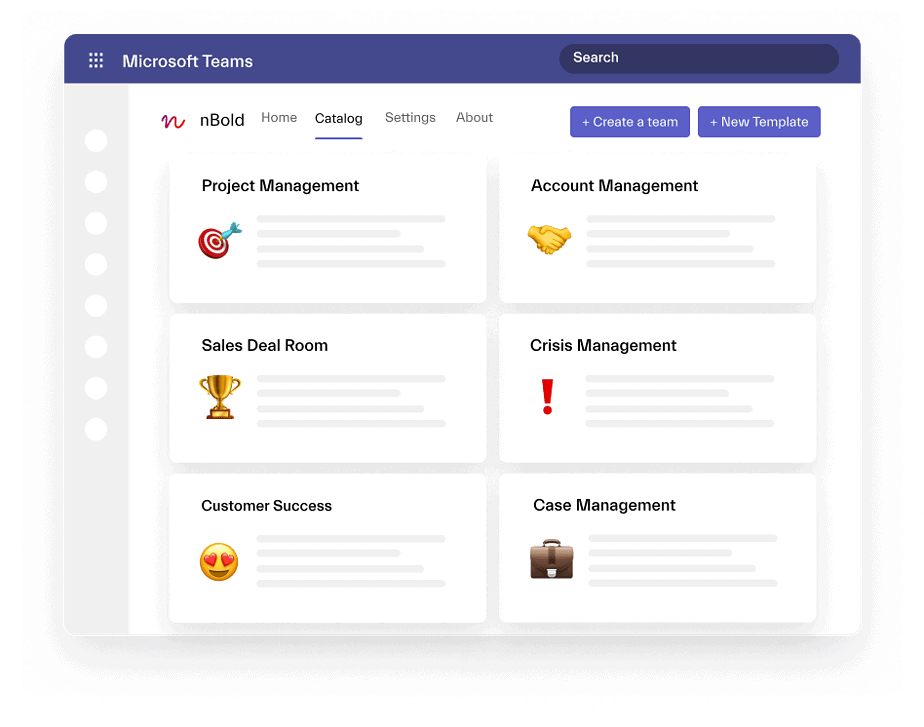
Standardizing Microsoft Teams creation with nBold Collaboration Templates
Collaboration Templates by nBold provide a powerful solution for standardizing Microsoft Teams creation. Here are the key features that make it a game-changer.
Naming Convention
nBold Collaboration Templates allow you to use fixed and dynamic naming conventions based on user Azure AD attributes. This means team names can change based on the user’s location, job title, function, etc. For example, whenever you need to create a team for a new project, you can establish the following naming rule:
Project – Project Name – User City
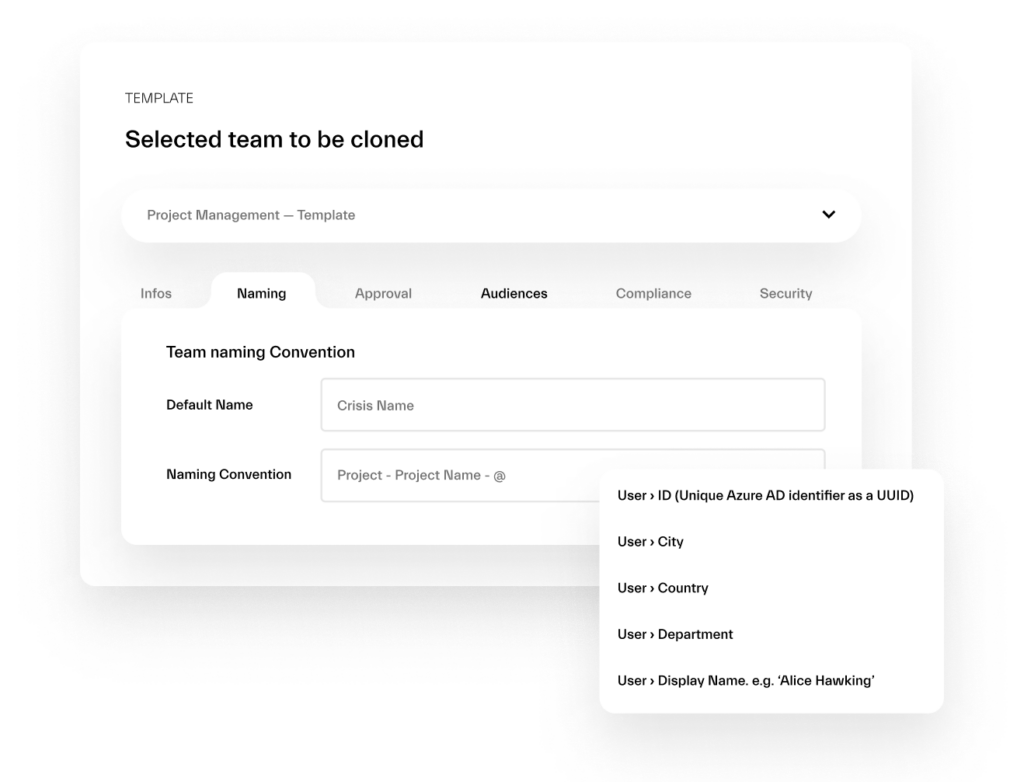
Approval Workflow
Collaboration Templates provide an approval process for new team creation. By enabling Approval Workflow you ensure that only authorized users can create new teams and helps maintain consistency in the creation process.
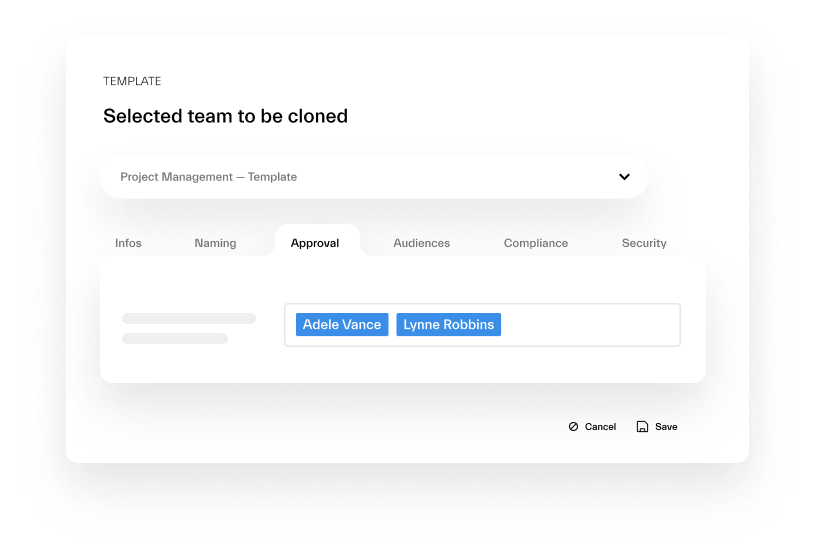
Channel structure

With Collaboration Templates, you can easily copy standard, private, and shared channels from the template to new teams. This saves time and ensures that new teams have the necessary spaces for focused discussion for their specific use case.
Create Collaboration Templates with pre-built structure, tools, and content in Microsoft Teams
Download our step-by-step guide on how to create Collaboration Templates for Microsoft Teams
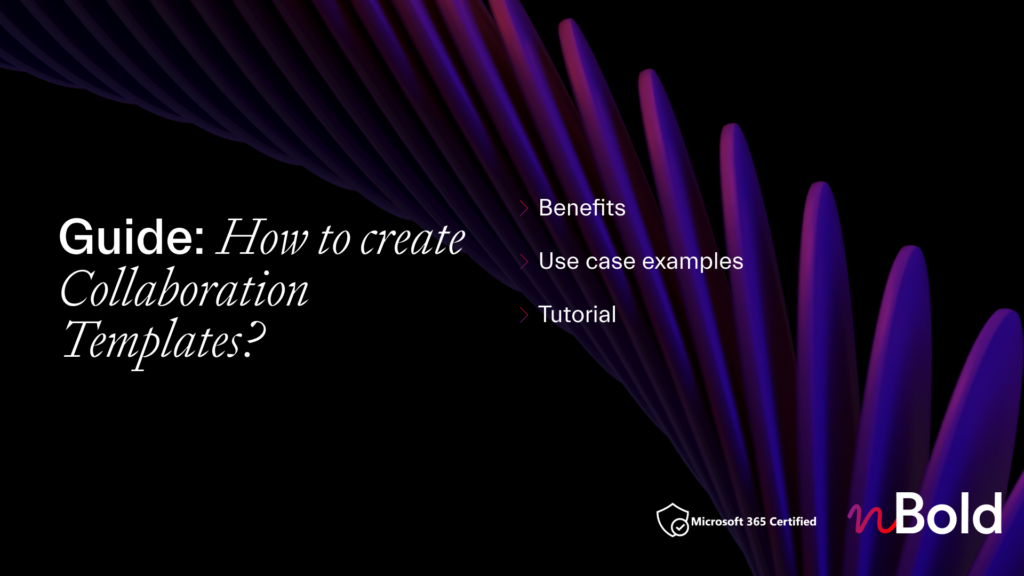
Cloning files and folders
You can also clone files and folders from Collaboration Templates to new teams. This means that important resources such as company policies, training materials, guidelines, sales decks, and other important documents can be easily shared with new teams.

Cloning of pre-configured tabs
Contrary to the native Teams templates, with nBold you can clone pre-configured tabs from the template to new teams. This means that apps and resources such as Planner tasks, OneNote, SharePoint document libraries, video resources on Stream and other tools can be easily set up in new teams. For example, you can pre-configure a Planner task list for new employees to help them track their onboarding tasks.

Permanent owners and members
Additionally, you can add permanent owners and members to new teams. This ensures that the right people have access to the right information and resources from the start.
Standardizing Microsoft Teams creation offers numerous benefits for organizations, including consistency, efficiency, compliance, and visibility. By exploring the available solutions organizations can ensure a seamless and standardized Teams creation process.
Talk to our team to find out how we can help you standardize and customize Microsoft Teams.
